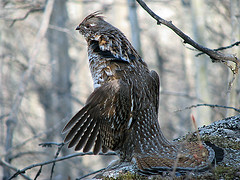Reproduction

The female lays a clutch (group of eggs) of about 8 - 12 cream colored eggs per season. After an average of 24 days of almost constant incubation by the female with only 2 short breaks each day for quick meals, the eggs hatch and the chicks feed on small insects. The young will fly in about 12 days, and after this, the adult female will go on her way, and the young are on their own.
The average life expectancy for the ruffed grouse is 1 year, but if the bird survives its first year, it is likely to live 2-3 years.
The mating process of the ruffed grouse is very distinctive. The male attracts females by perching on a fallen log, fanning his wings, extending his ruff, and making a noise most often described as "drumming" by rapidly beating his wings. The sound is similar to a motor starting, as can be seen in the video below. The female makes a nest on the ground usually at the base of a tree or under a bush, lining it with leaves and feathers. Each male and female will mate with more than 1 partner during a breeding season.
Make sure your volume is turned up so you can hear the drumming sound the grouse makes by flapping its wings! Video by Guy L. Monty.
The population count of ruffed grouse tends to follow a cycle pattern of highs and lows every 8-10 years, although researchers are not fully sure why this is, some say it's in correlation to the snowshoe hare population. When the hare numbers are down, their primary predator, hawks, turn to the grouse as a food source, decreasing their numbers.